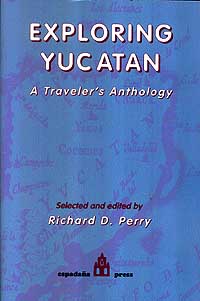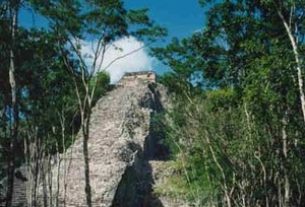Exploring the Yucatan – A Traveler’s Anthology, By Richard D. Perry.
A Review
 Indispensable for anyone heading for the Mayan world of the Yucatan and equally interesting for those who have been there, this Traveler’s Anthology gives a comprehensive overview of the exploration of the area. Although it not really a guide-book, it offers a glimpse of the area that goes back some 485 years. The book begins with short biographical sketches of, and reports from, those who first explored the Yucatan and brought the Mayans to the attention of the world. We get their first impressions of the wonders of the Mayan civilization as they were discovered.
Indispensable for anyone heading for the Mayan world of the Yucatan and equally interesting for those who have been there, this Traveler’s Anthology gives a comprehensive overview of the exploration of the area. Although it not really a guide-book, it offers a glimpse of the area that goes back some 485 years. The book begins with short biographical sketches of, and reports from, those who first explored the Yucatan and brought the Mayans to the attention of the world. We get their first impressions of the wonders of the Mayan civilization as they were discovered.
The book is not organized chronologically. Readers find themselves skipping backward and forward through time. Some readers may find this distracting but overall the book presents a fascinating study of both the Mayans and those who braved the hardships of travel into what is, even today, a jungle.
“Part One,The Early Accounts,” deals with the early contacts between Mayans and Europeans. The very first occurred in 1502 when Christopher Columbus, then on his fourth voyage, encountered a Mayan trading canoe in the Gulf of Honduras. Loaded with cotton cloth, Cacao, copper axes and bells, flint knives and slaves, it gave the Spaniards a fleeting glimpse of the accomplishments of one the most advanced civilizations in Mezzo-America, but was quickly forgotten.
The classic period of Mayan civilization was between 200 and 1000 AD. By the time the Spaniards arrived, the great Mayan cities had been abandoned, but the Mayans were still mighty warriors. In “The Conquest of Nueva Espagna,” Bernal Diaz, reports on previous visits to the Yucatan.. He had visited the area, first with Hernandez de Cordoba in 1517 and a year later with Juan de Grijalva. However, these accounts made little impression on the Spaniards. They were after gold and the silver. The Yucatan had none.
It was not until the 1560’s that the Mayans re-appear in history. The book offers a report written by the third Bishop of the Yucatan, Diego de Landa that gives a detailed physical description of the Mayans, their religion and social structure. His matter-of fact report of the destruction of Tiho, an ancient Mayan site, whose buildings were torn down to provide building materials for Merida, gives us a clue about the Spanish attitude toward the native culture.
The first discovery of remnants of a Mayan city that lay hidden in the Yucatan jungle came in 1588, when a young priest, Fray Antonio de Cuidad Real, started to explore the area. His descriptions of the Yucatan and its natives are very detailed. It was he who discovered and described Uxmal, the first site from the classic Mayan period to come to the attention of the Spaniards. However, it was not until 1835 that the city again came to the attention of the world.
Part Two, titled “Incidents of Travel” consists of descriptions of the experiences of early travelers to the area. We begin to get detailed accounts, dating back to 1842, of conditions in the area. By the late 1880’s many long forgotten ruins had been found. Visitors to the Yucatan can now visit Chichen Itza, Coba and Uxmal plus many lesser-known sites.
The book describes early Merida, the Yucatan’s principal city from the days of its founding. In Chapter Three titled, “Uxmal and the Puuc Region,” we get the actual report about Uxmal written by Antonio de Cuidad de Real in 1588 which had been ignored by his contemporaries.
Despite the reports of the early explorers, the study of the area was spasmodic. Well into the 20th century there were those who refused to acknowledge that the indigenous people had developed the magnificent architecture of the ruins being uncovered. The sagas continue into the 1990’s. By gathering and reporting the findings of those who explored the area, hopefully Richard D. Perry has finally put to rest crackpot theories that credited “European” or even “Extra-terrestrials visitors” with having designed the Mayan ruins.
“Exploring Yucatan” might well have been subtitled, “Mexico’s Last Frontier,” for even now it remains isolated, it’s inhabitants fiercely independent. For serious students, the author has included two and a half pages of source material, a list of suggested further readings and a glossary of terms.
Copyrighted in 2001, it is available from Espadana Press, P.O. Box 31067, Santa Barbara, Ca.93103, at a cost $20.00 plus $3.00 shipping and handling, or from Amazon.com

